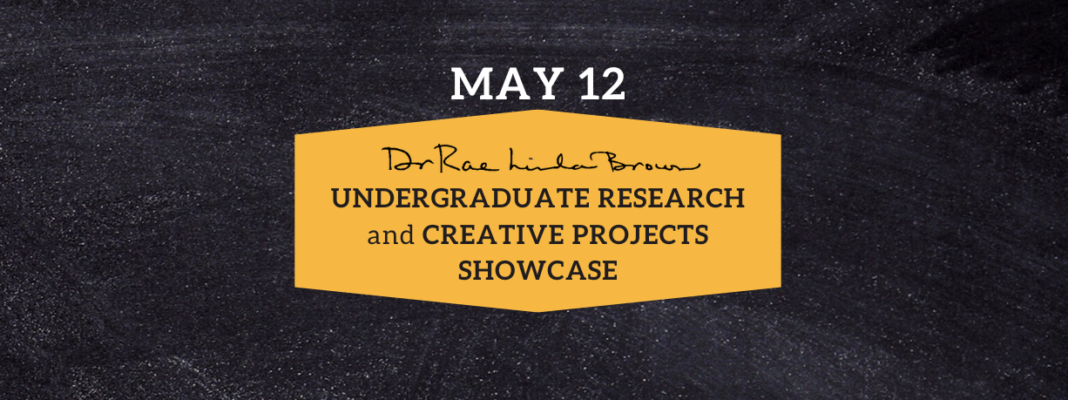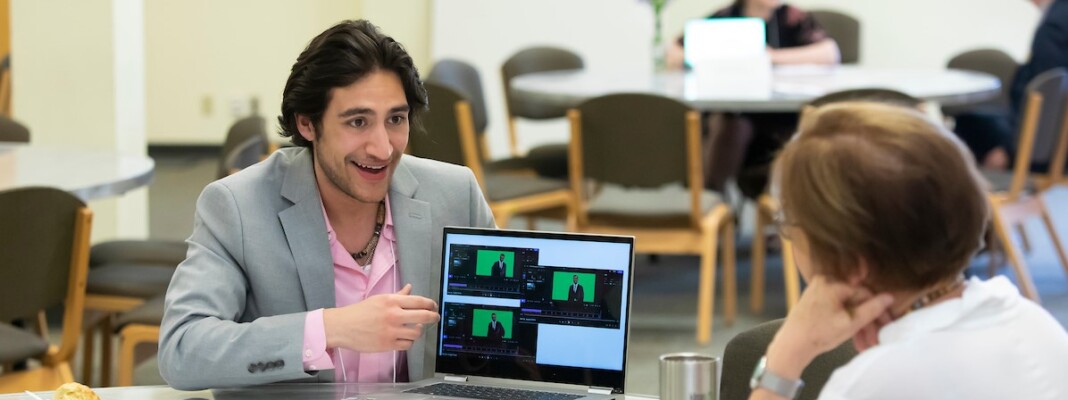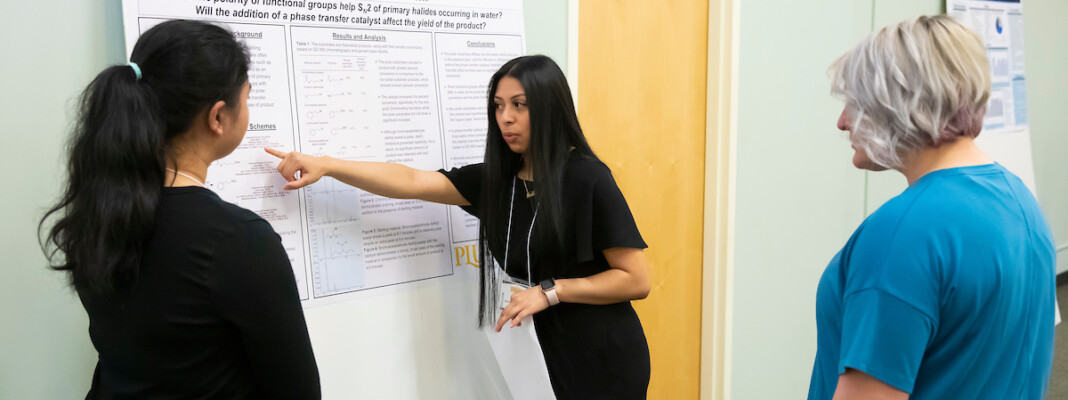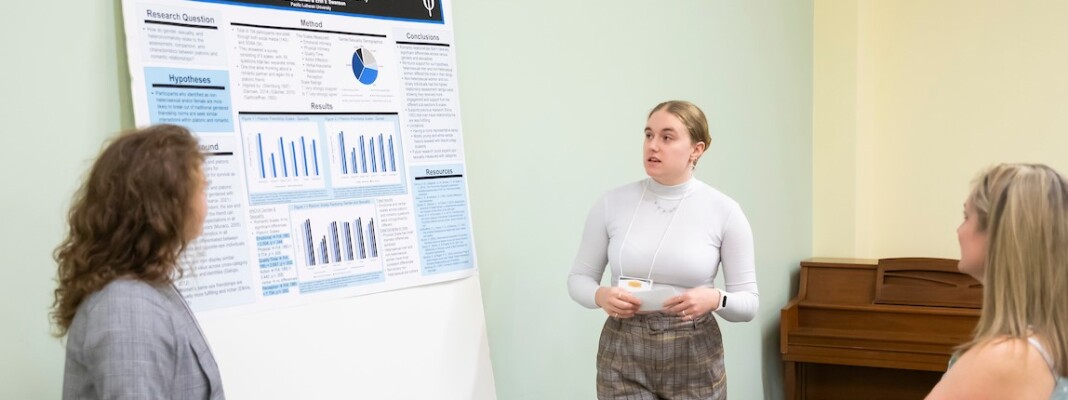2023 Rae Linda Brown Undergraduate Research and Projects Showcase
May 12, 2023 | 9:00 am – 12:00 pm
9:00 am | Opening Welcome
Joanna Gregson, Provost and Senior Vice President for Academic Affairs
9:10 am | Opening Presentation
| Student(s) | Presentation |
|---|---|
| Hailey Wharton | Soprano Sings Opera Faculty Mentor: LeeAnne Campos, Music Hailey Wharton, soprano, gives context for various operas and performs arias from roles in her vocal fach, including "Bel Piacere" by George Friderich Handle, "Always Through the Changing" by Douglas Moore, "Una Donna a quindici anni" by Wolfgang Amadeus Mozart, and "Sul fil d'un Soffio" by Giuseppe Verdi. Accompanied by Fiona Ashton-Knochel. |
Faculty Moderator: Bridget Yaden, Hispanic and Latino Studies / Office of the Provost
| Student(s) | Presentation |
|---|---|
| G Alvarado | Through Science comes Art Faculty Mentor: Amanda Sweger, Theatre & Dance Creating animations, stories, and visual effects through creative problem solving in both Computer Science and Art. Sit back and enjoy the magic as we go on this journey...Through Science Comes Art |
| Parker Brocker-Knapp (2023 Kelmer-Roe Research Fellowship Recipient) | The Act and Art of Translation: A Contextually Responsive Approach to Oral Testimonies of the Jewish Diaspora in Uruguay Faculty Mentors: Giovanna Urdangarain, Hispanic and Latino Studies; Rona Kaufman, English This research examines the efficacy of established approaches to the translation of literary works when used to translate oral testimonies, offers a new contextually responsive approach to the translation of oral testimonies, and does so through the transcription and translation of 14 video and audio testimonials of Uruguayan Holocaust victims. |
| Kasey Gardner | French LGBTQ+ Fiction, in English: a brief illustration of the art of translation Faculty Mentor: Rebecca Wilkin, Languages and Literatures - French I prepared a sample of a French novel in translation to submit to American publishing houses to gain experience in the art of translating and working in the publishing arts. This piece details how I came to be interested in translation, the challenges I encountered while working on this project, and what I learned from it. |
| Allen Benjamin Tugade | Relative Gender Experiences: Gay Men’s Distribution of Emotion Work and Distress Transmission Faculty Mentors: Laura Fitzwater Gonzales, and Laura McCloud; Sociology and Criminal Justice This project is a sociologically centered project using qualitative data to study the ways in which gay men's distribution of emotion work and distress transmission act as markers for the gender differences in romantic relationships. |
Faculty Moderator: Ann Auman, Biology/College of Natural Sciences
Faculty Mentor: Neal Yakelis, Chemistry
| Student(s) | Presentation |
|---|---|
| Camilee M. Boland; Audrey M. Borloz; Jordan R. Vanni | Utilizing an azo dienophile for isolation of naturally-occurring dienes in essential oils by a retro-Diels-Alder reaction The Diels-Alder reaction can be studied through various strategies including the use of naturally-occurring dienes found in essential oils. Essential oils, long used for their anti-inflammatory and anti-microbial properties, have important applications in the biomedical and pharmaceutical industries. Naturally occurring dienes can be purified from essential oils through a Diels-Alder reaction with 4-phenyl-1,2,4-triazoline-3,5-dione (PTAD) as a highly reactive azo dienophile, followed by a retro-Diels-Alder reaction in the presence of a strong base. This two-step method will be used to study and isolate four dienes present in essential oils: zingiberene (ginger oil), myrcene (thyme or verbena oil), α-phellandrene (eucalyptus oil), and α-terpinene (marjoram oil). Analysis of the isolated retro-Diels-Alder diene products, as supported by NMR and GC/MS characterization analysis, can aid in the understanding of how the structures of dienes contribute to their reactivity trends. |
| Danielle Cox; Angela Rodriguez Hinojosa | A greener SN2: Substitution reactions of polar and nonpolar primary halides in water Substitution reactions are very important when building complex organic compounds. However, they are often performed in hazardous polar, aprotic solvents like dimethylformamide (DMF). By utilizing water as a solvent, we can adapt a greener method for SN2 reactions of primary halides. Previous student research found that substrate solubility and a phase transfer catalyst both affected the reaction progress and yield. We will explore the scope of this reaction by comparing the reactivity of primary alkyl halides containing polar functional groups, such as 4-bromo n-butyl acetate and bromoacetaldehyde diethyl acetal,to nonpolar counterparts in the presence of a thiocyanate nucleophile. The reactions are typically heated in water at 110 °C in a laboratory microwave reactor. The results of the experiments are characterized using a variety of instruments: 1H NMR, 13C NMR, FT-IR, and GC-MS. |
| Fani Del Toro; Rhonwyn Fleming | Iodine takes the lead: Efficient synthesis of carbostyril 124 Carbostyril 124 is an important compound in medical research due to its fluorescent properties which improve the detection limits of small biological compounds. This characteristic leads to various biomedical applications such as DNA and RNA detection. Based on literature reports of the synthesis of a related class of dyes called coumarins, it was hypothesized that the condensation reaction to form carbostyril 124 could be catalyzed by iodine (I2). Molecular iodine can be an effective catalyst due to its selective reactivity with organic compounds and mild Lewis acidity. In our experiment, we examined whether the catalytic loading of iodine and the temperature of the reaction are important factors in improving the yield of the reaction. The methods used to characterize the product include thin layer chromatography (TLC), NMR spectroscopy, and FTIR spectroscopy. |
| Kayden N. Hulquist; Elijah D. Singleton; Grady D. Lemma | Green (and orange) catalysts: root vegetable-catalyzed reduction reactions Biocatalysts offer a promising horizon for green chemistry. Vegetable-catalyzed reductions may employ enzymatic alternatives to harsher reactions using more hazardous reagents. Reduction reactions were explored using various root vegetables including Daucus carota (carrot) and Helianthus tuberosus (sunchoke). Literature experiments were replicated to assess each vegetable’s potential efficiency in reducing functional groups such as ketones. Select substrates underwent a reduction reaction in water with shredded vegetable matter being the sole reagent. They were allowed to react for 2-3 days in an orbital shaker (160 rmp). The potential for reducing different functional groups such as α-ketoesters, aldehydes, α,β-unsaturated carbonyl compounds, and alkenes will also be explored. |
| Eva Wirth; Sean Majia | Exploration of a photoluminescent azaxanthone dye through a two-step cyclization synthesis The azaxanthone functional group has applications in study of biomolecules because it can be incorporated into photoluminescent lanthanide antenna complexes. Using characterization methods like gas chromatography mass spectrometry, Fourier-transform infrared spectroscopy, and nuclear magnetic resonance spectroscopy, we investigated the synthesis of a specific azaxanthone to study its potential beneficial uses as a bioluminescent sensitizer. Previous research had shown that the first step to form the intermediate MCPMNA (2-((4-methoxycarbonylphenoxy))-6-methyl nicotinic acid), could be accomplished by use of chloromethylnicotinic acid in a nucleophilic aromatic substitution reaction. The Friedel-Crafts acylation reaction to form the cyclized target azaxanthone was explored using mild Lewis acid catalysis like ytterbium(III) triflate, Yb(OTf)3, in order to forgo the use of large quantities of the corrosive, viscous polyphosphoric acid as a solvent. |
Faculty Moderator: Heather Mathews, Communication, Media & Design Arts
| Student(s) | Presentation |
|---|---|
| Mackenzie Mayhem | The Journey of Self Faculty Mentors: Alex Krajkowski, and Heather Mathews; Communication, Media & Design Arts I will be presenting an artist book that looks at three components of identity: intuitive, constructed, and performative. The book is a vessel to hold my deconstructed identity categorized in this way. The book is a combination of graphic design, book arts, print making, and other forms of art making. |
| Emily Metzler | The Philosophy of a Flowers Life Faculty Mentor: Alex Krajkowski, Communication, Media & Design Arts This project will focus on cliche photos we see daily in the media, with a bit of a twist. I have taken some photos of flowers for a photography class that is not the typical photos that one would see on social media. I have taken four photos all representing a certain stage in the flowers' life. |
| Adrienne Slawik | Mnemic Design: The Cohesion of Dream and Memory Faculty Mentor: Heather Mathews, Communication, Media & Design Arts Mnemic design is about exploring the emotional, introspective, and nostalgic concepts of your memories and dreams that blur the quiet edge of reality: combining signs and photograms to create an image that tells a story of some moment so it may not be lost to time or decay. Your image captures a curated memory that then becomes a unique memory to the viewer based on their own interpretations and ways of seeing. |
| Georgia Smith | Uprooted Faculty Mentors: Alex Krajkowski, and Heather Mathews; Communication, Media & Design Arts A tree hanging in the air. Ethereal, and transparent, allowing the viewer to look through the tree from the roots inward. This tree will be 6X6X8 feet. Uprooted hanging from the ceiling, the focus of the tree will be the roots. There will be no canopy, focusing on the trunk and its relation to the roots. This tree will be constructed of cheese cloth. Constructed to hold hollow space. |
Faculty Moderator: Bridget Yaden, Hispanic and Latino Studies/ Office of the Provost
| Student(s) | Presentation |
|---|---|
| Fulton Bryant-Anderson | Reinventing Call of Duty: Technology and Travel in Historical First-Person Shooter Video Games Faculty Mentor: Mike Halvorson, History This project investigates the development of playable environments in Call of Duty 2 (2005) and Call of Duty World at War (2008) from Infinity Ward’s video game series Call of Duty. The environments in these video games reveal distinct post-9/11 interpretations of war. |
| Sarah Calvin-Stupfel | Witnessing Testimony, Creating Memory, and Re-Building Self: Lessons from Molly Applebaum’s Testimonies in "Buried Words" Faculty Mentor: Rona Kaufman, English This project, consisting of a 30 page essay and 15 minute presentation, came out of my 2022 Kurt Mayer Research Fellowship. I presented my research at the Powell-Heller Conference for Holocaust Education last October. My essay focuses on the testimonies of Molly Applebaum, a Polish-Canadian Holocaust survivor who kept a diary during the war, and wrote a memoir several decades later. |
| Ellie Dieringer (2023 Wang Center Student-Faculty Research Recipient) | Identity and Material Memory: Holocaust Museums in the Southern Cone Faculty Mentor: Giovanna Urdangarain, Hispanic and Latino Studies This project explores the interplay between memory and testimony, witnessing and listening, and migration and identity. The investigation centers around museums as rhetorical spaces that contribute to the construction of collective memory, emphasizing narratives of survival, resilience, and identity for Holocaust survivors living in Uruguay and Argentina. |
| Venice Jakowchuk | A Comparative Stylistic Analysis of Calixtlahuaca Projectile Points Faculty Mentor: Bradford Andrews, Anthropology This project analyzes projectile points found in Calixtlahuaca, central Mexico (1130 – 1530 AD). Through visual and comparative analysis the Calixtlahuaca projectile points were technologically classified according to a lithic technology approach. The goal of this research was to determine if certain styles were associated with a region or reused. |
| Isaac Madsen-Bibeau | How Socioeconomic Class Affects Low-Income College Students's Interpersonal Relationships Faculty Mentors: Lauri McCloud, Kate Luther, and Gerardo Cuevas-Buendia; Sociology and Criminal Justice For this sociology capstone project, I interviewed 8 undergraduate students who self identified as Pell Grant Eligible. Participants answered questions surrounding their experiences with socioeconomic class and interpersonal relationships. The research is based on Foucault's theories, which understand that large social structures are played out and reified by individuals. |
| Kimberley Stanley; Yasmin Lopez | Walk O’ Clock: The Design and Implementation of a Health Promotion Program in a College Community Faculty Mentor: Harry Papadopoulos, Kinesiology The purpose of this creative project was to design and implement a health promotion program at Pacific Lutheran University using knowledge learned in the Health & Fitness Promotion course. The class agreed to implement a week-long walkathon to reduce sedentary behaviors and increase walking habits among students, staff, and faculty. |
Faculty Moderator: TBD
| Student(s) | Presentation |
|---|---|
| Rebecca Auman; Erin Swanson | Romantic and Platonic Interpersonal Relationship Differences in Relation to Gender and Heteronormativity Faculty Mentors: Heidi McLaughlin, and Corey Cook; Psychology Our research found that participants who identified as non-heterosexual and/or female are more likely to break out of traditional gendered friendship norms and seek similar interactions within platonic and romantic relationships. This is consistent with previous research that found non-heterosexual women have more fulfilling platonic relationships than most men. |
| Chantelle Davenport; Susan Lopez; Mollie Walker | Bicycling Power Output Differences For Individuals Utilizing Different Hand Grips Faculty Mentors: Charlie Katica, and Andrew Del Pozzi; Kinesiology This study was designed to investigate the impact of grip and support on power output for cycling with simulated amputated and non-amputated arms. The results of the study will help provide insight and clarifications to the impacts of an upper extremity amputation for Union Cycliste Internationale (UCI) classification of Paracyclists. |
| Logan Denen (2023 Severtson Awardee) | Trusting a Stranger: Children's Understanding of Expertise in Food Safety Faculty Mentors: Marianne Taylor, and Heidi McLaughlin; Psychology Research was conducted to look at how children of different ages respond to information about food safety from different experts. Additionally, pre-COVID data compared to post-COVID data was assessed. |
| Lorelei Eddy; Alan Oakley | Parent Views on Child Biological Knowledge Faculty Mentors: Marianne Taylor, and Heidi McLaughlin; Psychology Our project looks at how parents understand children's level of comprehension of biological knowledge, food contamination, general illness, and COVID. Parents are given a survey where questions like how often does your child ask about "x topic", and how comfortable are you with answering questions about "X topic." |
| Joni Leahy; Yasmin Lopez | Effects of HeartMath Intervention on Undergraduate Student Perceived Stress and Well-Being Faculty Mentor: Nicky Martin, Kinesiology This study investigated the effectiveness of HeartMath's online resilience educational program. Participants included undergraduate students; and both quantitative and qualitative measures were used to evaluate the program effectiveness relative to perceived stress and well-being for this specific population. |







